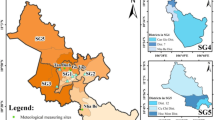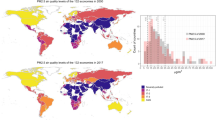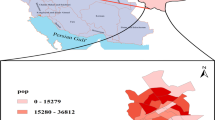Abstract
Consumption of fossil fuels in residential, industrial, and transportation sectors has a significant contribution to air pollution and high attributable premature deaths. To target specific strategies for reducing health effects, the anthropogenic sources and their contributions should be identified. This article provides an integrated modeling approach to evaluate the sector-specific contributions of different PM2.5 sources on air pollution and relevant health impacts. The dispersion of emissions from different sources is modeled by the American Meteorological Society/Environmental Protection Agency Regulatory Model (AERMOD), and the health impacts are estimated by the Environmental Benefits Mapping and Analysis Program—Community Edition (BenMAP-CE), while the global exposure mortality model (GEMM) is used as the health impact function. The methodology is applied for the special region in Qazvin province, Islamic Republic of Iran. The total premature deaths from exposure to PM2.5 which are attributable to the suburban transportation systems, industries, and towns and villages (domestic sector and intra-urban transportation systems) are 108.1, 96.3, and 653.4 that are equal to 4%, 4%, and 24% of the total premature deaths, respectively. In some cases, the spatial distribution of PM2.5 from different emission sources, altogether, is not compliant with the limits, while their single distribution is compliant with the limit. This synergy effect is very important for sustainable environmental planning in the region. The results show that the emissions of PM2.5 from towns and villages play a major role in public health, and thus, additional measures and investigations should be implemented to further reduce PM2.5 pollutions and protect public health in the urban area in the future. This research suggests a framework to identify the sources of the health impacts and help policymakers to carefully design the environmental action plans in the region.










Similar content being viewed by others
Data availability
The datasets generated and/or analyzed during the current study are not publicly available. However, some of them are available from the corresponding author on reasonable request and under the permission of authorities.
Notes
In the country, the spring is from March 21 to June 21, the summer starts from June 22 and ends to September 22, the fall is from September 23 to December 21, and the winter starts from December 22 and ends to March 20.
Abbreviations
- AERMOD:
-
American Meteorological Society/Environmental Protection Agency Regulatory Model
- AQBAT:
-
Air Quality Benefits Assessment Tool
- \({\mathrm{A}}_{\mathrm{T}}\) :
-
The total residential area of Qazvin province that is heated (m2)
- BenMAP-CE:
-
Environmental Benefits Mapping and Analysis Program—Community Edition
- BPIP:
-
Building Profile Input Program
- c( x,y,z ) :
-
Air pollution concentration (\({~}^{\mu g}\!\left/ \!\!{~}_{{m}^{3}}\right.\))
- CALPUFF:
-
California Puff
- COPD:
-
Chronic obstructive pulmonary disease
- GDP:
-
Gross domestic product
- GEMM:
-
Global exposure mortality model
- GIS:
-
Geographic information system
- h:
-
The average height of residential units (m)
- H:
-
The heating load of a building per volume unit (W/m3)
- Hz :
-
Effective stack height (m)
- IAQS:
-
Iranian Ambient Air Quality Standard
- IHD:
-
Ischemic heart disease
- LC:
-
Lung cancer
- LRI:
-
Lower respiratory infections
- N:
-
The number of residential units in each town or village
- NAAQS:
-
National Ambient Air Quality Standard
- NCD:
-
Non-communicable diseases
- \({\mathrm{N}}_{\mathrm{T}}\) :
-
The number of residential units in the province
- PM:
-
Particulate Matter
- Q:
-
Emission rate (g/s)
- \({\mathrm{Q}}_{\mathrm{H}}\) :
-
Heating load in each town or village
- u:
-
Effective wind speed (m/s)
- WHO:
-
World Health Organization
- \({\sigma }_{y}\) :
-
Horizontal dispersion parameters (m)
- \({\sigma }_{z}\) :
-
Vertical dispersion parameters (m)
References
Abyek Cement Company (2016) Report on the performance of the Board of Directors to the Annual General Meeting
Ahmadi M, Salamat Y, Shahbazi H, Company R prepared by TMAQC (2015) Pollution dissemination list of Tehran for the year 2013 Based on: Home and commercial resources (Volume 3)
Altieri KE, Keen SL (2019a) Public health benefits of reducing exposure to ambient fine particulate matter in South Africa. Sci Total Environ 684:610–620. https://doi.org/10.1016/j.scitotenv.2019.05.355
Altieri KE, Keen SL (2019b) Public health benefits of reducing exposure to ambient fi ne particulate matter in South Africa. Sci Total Environ 684:610–620. https://doi.org/10.1016/j.scitotenv.2019.05.355
American Society of Plumbing Engineers (2015) Domestic hot water systems
Anenberg SC, Belova A, Brandt J et al (2016) Survey of ambient air pollution health risk assessment tools. Risk Anal 36:1718–1736. https://doi.org/10.1111/risa.12540
Arzumand M, Kazemzadeh S (2002) Fuel modeling in the domestic sector in Iran. In: The second conference on optimizing fuel consumption in buildings (Persian). Tehran
Australian Government: Department of Sustainability, Environment, Water P and C (2012) Emission estimation technique manual for fossil fuel electric power generation. Australian
Barkhordar ZA, Saboohi Y (2014) Modelling useful energy demand system as derived from basic needs in the household sector. Energy Effic 7:903–921. https://doi.org/10.1007/s12053-014-9257-7
Bayat R, Ashrafi K, Shafiepour Motlagh M et al (2019) Health impact and related cost of ambient air pollution in Tehran. Environ Res 176:108547. https://doi.org/10.1016/j.envres.2019.108547
Bergin MS, Harrell M, Janssen M (2012) Locomotive emission inventories for the United States from ERTAC rail. United States Environmental Protection Agency
Burnett R, Chen H, Szyszkowicz M et al (2018) Global estimates of mortality associated with longterm exposure to outdoor fine particulate matter. Proc Natl Acad Sci U S A 115:9592–9597. https://doi.org/10.1073/pnas.1803222115
Cai H, Bumham A, Wang M (2013) Updated emission factors of air pollutants from vehicle operations in GREET using MOVES. Argonne National Laboratory, U.S. Department of Energy
Country Roads Management Center (2019) Traffic information
Dechezleprêtre A, Rivers N, Stadler B (2019) The economic cost of air pollution: evidence from Europe. https://doi.org/10.1787/56119490-en
Deputy Minister of Planning and Economics of Transportation-Railways of the Islamic Republic of Iran-Ministry of Roads and Urban Development (2017) Statistical yearbook of Iranian rail transportation
EMEP EEA (2019) EMEP/EEA air pollutant emission inventory guidebook 2019: cement production. 1–18
EPA (2016) Technical support document (TSD) for replacement of CALINE3 with AERMOD for transportation related air quality analyses. https://www3.epa.gov/ttn/scram/appendix_w/2016/CAL3_AERMOD_Replacement_TSD.pdf. Accessed 8 Jun 2020
EPA (2020) Environmental Benefits Mapping and Analysis Program - Community Edition (BenMAP-CE). https://www.epa.gov/benmap. Accessed 5 Jun 2020
Esri (2021) ArcGIS desktop, desktop GIS software suite. https://www.esri.com/en-us/arcgis/products/arcgis-desktop/overview. Accessed 26 Jun 2020
Farzad K, Khorsandi B, Khorsandi M et al (2020) A study of cardiorespiratory related mortality as a result of exposure to black carbon. Sci Total Environ 725:138422. https://doi.org/10.1016/j.scitotenv.2020.138422
Fuel Consumption Optimization Company (2016) Iran light vehicle fuel consumption guide
Iran Institute of Standards and Industrial Research (2005) Criteria and technical specifications of electrical and thermal energy consumption and energy groups in the cement production process
Iran ministry of Industry and mine & trade (2018) Production and trade capacity database. In: Minist. Ind. Mine Trade. en.mimt.gov.ir/index.php. Accessed 20 Sep 2019
Iran Small Industries and Industrial Parks Organization (2018) List of operating units located in towns and industrial areas of Qazvin province. In: Iran Small Ind. Ind. Park. Organ. http://isipo.ir/index.jsp?fkeyid=&siteid=1&pageid=701&ostan=&code=17. Accessed 12 Jun 2020
Iranian Standards and Industrial Research Organization National Standard of Iran: 2–1220 (n.d.) Chimney-burning gas heater-technical specifications and method of determining energy consumption criteria and energy label instructions
Koiwanit J, Manuilova A, Chan C, Wilson M (2016) International Journal of Greenhouse Gas Control Human health risks of post- and oxy-fuel combustion carbon dioxide capture technologies : hypothetically modeled scenarios. Int J Greenh Gas Control 47:279–290. https://doi.org/10.1016/j.ijggc.2016.02.002
Krewski D, Jerrett M, Burnett RT, et al (2009) Extended follow-up and spatial analysis of the American Cancer Society study linking particulate air pollution and mortality. Res Rep Health Eff Inst
Lazaridis M (2011) First principles of meteorology and air pollution. Springer, Dordrecht
Lelieveld J, Pozzer A, Pöschl U et al (2020) Loss of life expectancy from air pollution compared to other risk factors: a worldwide perspective. Cardiovasc Res 116:1910–1917. https://doi.org/10.1093/cvr/cvaa025
Levy JI, Biton L, Hopke PK et al (2017) A cost-benefit analysis of a pellet boiler with electrostatic precipitator versus conventional biomass technology : a case study of an institutional boiler in Syracuse, New York. Environ Res 156:312–319. https://doi.org/10.1016/j.envres.2017.03.052
Luo G, Zhang L, Hu X, Qiu R (2020) Quantifying public health benefits of PM2.5 reduction and spatial distribution analysis in China. Sci Total Environ 719:137445. https://doi.org/10.1016/j.scitotenv.2020.137445
Macêdo MFM, Ramos ALD (2020) Vehicle atmospheric pollution evaluation using AERMOD model at avenue in a Brazilian capital city. Air Qual Atmos Heal 13:309–320. https://doi.org/10.1007/s11869-020-00792-z
Maji KJ, Dikshit AK, Arora M, Deshpande A (2018a) Estimating premature mortality attributable to PM2.5 exposure and benefit of air pollution control policies in China for 2020. Sci Total Environ 612:683–693. https://doi.org/10.1016/j.scitotenv.2017.08.254
Maji KJ, Ye W-F, Arora M, Shiva Nagendra SM (2018b) PM2.5-related health and economic loss assessment for 338 Chinese cities. Environ Int 121:392–403. https://doi.org/10.1016/j.envint.2018.09.024
Nameghi HM (2013) A case study of integrated modelling of traffic, vehicular emissions, and air pollutant concentrations for Huron Church Road, Windsor. Windsor
Poorfakhraei A, Tayarani M, Rowangould G (2017) Evaluating health outcomes from vehicle emissions exposure in the long range regional transportation planning process. J Transp Heal 6:501–515. https://doi.org/10.1016/j.jth.2017.05.177
Pozzer A, Zimmermann P, Doering UM et al (2012) Effects of business-as-usual anthropogenic emissions on air quality. Atmos Chem Phys 12:6915–6937. https://doi.org/10.5194/acp-12-6915-2012
Qazvin Management and Planning Organization (2017) Statistical yearbook of Qazvin Province. Qazvin
Statistical Center of Iran (2014) Detailed results of the general census of agriculture in Iran -. In: Natl. Stat. Portal Iran
Statistical Center of Iran (2016) Results of statistics on energy consumption and environmental characteristics of urban households in 2016
Sun J, Fu JS, Huang K, Gao Y (2015) Estimation of future PM2.5- and ozone-related mortality over the continental United States in a changing climate: an application of high-resolution dynamical downscaling technique. J Air Waste Manage Assoc 65:611–623. https://doi.org/10.1080/10962247.2015.1033068
Supply and Distribution Management- National Iranian Petroleum Products Distribution Company (2016) Statistics on energy consumption of energy petroleum products. Tehran
Tabatabai M (2003) Building facilities calculations, 7th edn. Roozbehan, Tehran
Takeshita T (2011) Global scenarios of air pollutant emissions from road transport through to 2050. Int J Environ Res Public Health 8:3032–3062. https://doi.org/10.3390/ijerph8073032
Tayarani M, Poorfakhraei A, Nadafianshahamabadi R, Rowangould GM (2016) Evaluating unintended outcomes of regional smart-growth strategies: environmental justice and public health concerns. Transp Res Part D Transp Environ 49:280–290. https://doi.org/10.1016/j.trd.2016.10.011
the Statistical Center of Iran (2020) CENSUS. https://irandataportal.syr.edu/census
Tian G, Qiao Z, Xu X (2014) Characteristics of particulate matter (PM10) and its relationship with meteorological factors during 2001–2012 in Beijing. Environ Pollut 192:266–274. https://doi.org/10.1016/j.envpol.2014.04.036
Torjesen I (2021) Fossil fuel air pollution blamed for 1 in 5 deaths worldwide. BMJ n406. https://doi.org/10.1136/bmj.n406
U.S. Environmental Protection Agency (1998) AP-42 - Natural gas combustion
U.S. Environmental Protection Agency (2010) AP-42 - fuel oil combustion
US EPA (n.d.) O AP-42: compilation of air emissions factors
Van Munster K (2018) Modeling health effects of particulate matter emissions from heavy duty diesel trucks involved in high volume hydraulic fracturing with BenMAP-CE
Vohra K, Vodonos A, Schwartz J et al (2021) Global mortality from outdoor fine particle pollution generated by fossil fuel combustion: results from GEOS-Chem. Environ Res 195:110754. https://doi.org/10.1016/j.envres.2021.110754
Voorhees AS, Wang J, Wang C et al (2014) Public health benefits of reducing air pollution in Shanghai: a proof-of-concept methodology with application to BenMAP. Sci Total Environ 485–486C:396–405. https://doi.org/10.1016/j.scitotenv.2014.03.113
WHO (2016) Concentrations of fine particulate matter (PM2.5). In: Glob. Heal. Obs. data. https://www.who.int/gho/phe/air_pollution_pm25_concentrations/en/. Accessed 11 Jun 2020
WHO (2018) Ambient (outdoor) air pollution. https://www.who.int/news-room/fact-sheets/detail/ambient-(outdoor)-air-quality-and-health. Accessed 9 Jun 2020
Yang P, Zhang Y, Wang K et al (2019) Health impacts and cost-benefit analyses of surface O3 and PM2.5 over the U.S. under future climate and emission scenarios. Environ Res 178:108687. https://doi.org/10.1016/j.envres.2019.108687
Zannetti P (1990) Gaussian Models. Air pollution modeling: theories, computational methods and available software. Springer US, Boston, pp 141–183
Acknowledgements
We gratefully acknowledge the support from Niroo Research Institute (NRI). We thank the anonymous reviewers for their careful reading of our manuscript and insightful comments and suggestions.
Author information
Authors and Affiliations
Corresponding author
Ethics declarations
Conflict of interest
The authors declare no competing interests.
Disclaimer
For specific applications, please contact the author regarding the scope of the model.
Additional information
Publisher's note
Springer Nature remains neutral with regard to jurisdictional claims in published maps and institutional affiliations.
Supplementary Information
Below is the link to the electronic supplementary material.
Rights and permissions
About this article
Cite this article
Rezazadeh, A.A., Avami, A., Mashayekhi, M. et al. Assessing the contribution of different sources in atmospheric dispersion of PM2.5 and related health impact in a region of Qazvin, Iran. Air Qual Atmos Health 15, 1379–1394 (2022). https://doi.org/10.1007/s11869-022-01163-6
Received:
Accepted:
Published:
Issue Date:
DOI: https://doi.org/10.1007/s11869-022-01163-6




